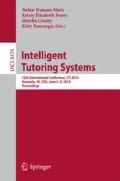Abstract
We examine a corpus of physics tutorial dialogues between a computer tutor and students. Either graphs or illustrations were displayed during the dialogues. In this work, stepwise linear regression, augmented to remove unwanted terms, is used to build models that identify situations when each graphic may aid learning. Our experimental results show that grouping students by pretest score, then by gender produces a model that significantly outperforms the baseline.
Access this chapter
Tax calculation will be finalised at checkout
Purchases are for personal use only
Preview
Unable to display preview. Download preview PDF.
References
Aist, G., Kort, B., Reilly, R., Mostow, J., Picard, R.: Experimentally augmenting an intelligent tutoring system with human-supplied capabilities: adding human-provided emotional scaffolding to an automated reading tutor that listens. In: IEEE International Conference on Multimodal Interfaces, pp. 483–490 (2002)
Arroyo, I., Beck, J.E., Park Woolf, B., Beal, C.R., Schultz, K.: Macroadapting animalwatch to gender and cognitive differences with respect to hint interactivity and symbolism. In: Gauthier, G., VanLehn, K., Frasson, C. (eds.) ITS 2000. LNCS, vol. 1839, pp. 574–583. Springer, Heidelberg (2000)
Chi, M., VanLehn, K., Litman, D.: Do micro-level tutorial decisions matter: Applying reinforcement learning to induce pedagogical tutorial tactics. ITS (2010)
D’Mello, S.K., Graesser, A.: Affect detection from human-computer dialogue with an intelligent tutoring system. In: Gratch, J., Young, M., Aylett, R., Ballin, D., Olivier, P. (eds.) IVA 2006. LNCS (LNAI), vol. 4133, pp. 54–67. Springer, Heidelberg (2006)
Ekstrom, R., French, J., Harman, H., Dermen, D.: Manual for kit of factor-referenced cognitive tests. Educational Testing Service, Princeton (1976)
Forbes-Riley, K., Litman, D.: Designing and evaluating a wizarded uncertainty-adaptive spoken dialogue tutoring system. Computer Speech & Language (2011)
Katz, S., Jordan, P., Litman, D., The Rimac Project Team: Rimac: A natural-language dialogue system that engages students in deep reasoning (2011)
Kohl, P.B., Finkelstein, N.D.: Student representational competence and self-assessment when solving physics problems. Phys. Rev. ST Phys. Educ. Res. (2005)
Kozhevnikov, M., Motes, M., Hegarty, M.: Spatial visualization in physics problem solving. Cognitive Science 31(4), 549–579 (2007)
Kulik, C., Kulik, J., Bangert-Drowns, R.: Effectiveness of mastery learning programs: A meta-analysis. Review of Educational Research 60(2), 265–299 (1990)
Lipschultz, M., Litman, D.: Illustrations or Graphs: Some Students Benefit From One Over the Other. In: Lane, H.C., Yacef, K., Mostow, J., Pavlik, P. (eds.) AIED 2013. LNCS (LNAI), vol. 7926, pp. 746–749. Springer, Heidelberg (2013)
McDermott, L., Rosenquist, M.: vanZee, E.: Student difficulties in connecting graphs and physics: Exampies from kinematics. American Journal of Physics (1987)
McNeil, N.M., Fyfe, E.R.: Concreteness fading promotes transfer of mathematical knowledge. Learning and Instruction, 440–448 (2012)
Meltzer, D.: Relation between students problem-solving performance and representational format. American Journal of Physics 73, 463 (2005)
Rau, M., Aleven, V., Rummel, N.: Intelligent tutoring systems with multiple representations and self-explanation prompts support learning of fractions. AIED (2009)
Van Heuvelen, A., Zou, X.: Multiple representations of work–energy processes. American Journal of Physics 69, 184–194 (2001)
VanLehn, K., Lynch, C., Schulze, K., Shapiro, J., Shelby, R., Treacy, D., Wintersgill, M.: The andes physics tutoring system: Lessons learned. IJAIED (2005)
Author information
Authors and Affiliations
Editor information
Editors and Affiliations
Rights and permissions
Copyright information
© 2014 Springer International Publishing Switzerland
About this paper
Cite this paper
Lipschultz, M., Litman, D. (2014). Modeling Student Benefit from Illustrations and Graphs. In: Trausan-Matu, S., Boyer, K.E., Crosby, M., Panourgia, K. (eds) Intelligent Tutoring Systems. ITS 2014. Lecture Notes in Computer Science, vol 8474. Springer, Cham. https://doi.org/10.1007/978-3-319-07221-0_54
Download citation
DOI: https://doi.org/10.1007/978-3-319-07221-0_54
Publisher Name: Springer, Cham
Print ISBN: 978-3-319-07220-3
Online ISBN: 978-3-319-07221-0
eBook Packages: Computer ScienceComputer Science (R0)

